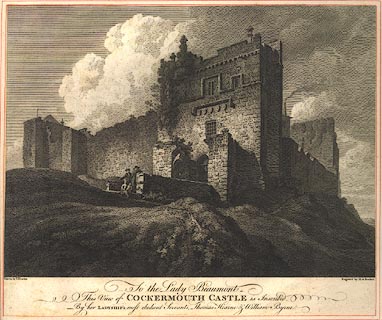

Dove Cottage : Lowther.43
image:-
© see bottom of page

click to enlarge
Plate 12 ?from the Antiquities of Great Britain, published 1786-1807.
Pasted in the Lowther scrapbook, vol.3; between pp.66-67; with descriptive text:-
COCKERMOUTH CASTLE / Is seated on an artificial mount at the confluence of the rivers Cocker and Derwent: the walls are of considerable extent, and bear evident marks of its being formerly a place well calculated for defence. / Concerning the founder of this Castle authors differ; some attribute its origin to Waldeof, first Lord of Allerdale, and son of Gospatrick Earl of Northumberland, in the time of William the Conqueror. By others we are told it was built by William de Meschines, who enjoyed the Honour of Cockermouth by gift of his brother Ranulph Earl of Chester, to whom the Conqueror had given the whole county of Cumberland. / The baronial Honour of Cockermouth, with that of Egremont, descended by marriages to the De Lucies, and to the Percies of Northumberland; and afterwards to Charles Seymour Duke of Somerset, and finally to the present Earl of Egremont. / During the civil war in the reign of Charles I. this Castle was garrisoned for the King; but being besieged and taken, was burnt, since which the inside has remained in ruins. / The exterior walls of this Castle are nearly square, and are decorated by several towers and bastions of the same figure, and one of a circular form that stands at the west end, and overlooked the conflux of the rivers. The interior part of the Castle is divided by the remaining walls into three distinct areas; the least of which affords an ample garden, for the use of the person who inhabits an apartment in the outer area, and takes care of the Castle. / The Print represents the north-east aspect, and entrance to the Castle. Over the gate are seen five shields, four of them, according to Cambden, bear the arms of the Moultons, Humfranvilles, Lucies, and Percies, and the other is said to belong to the Nevils. In this Tower, over the gate-way, are some habitable rooms, which are furnished for the convenience of the auditor who holds his courts in this Castle. / The View was taken in 1777. / No.XII.
Drawn by T. Hearne / Engrav'd by M. A. Rooker. / To the Lady Beaumont / This View of COCKERMOUTH CASTLE is inscribed / By her LADYSHIPS most obedient Servants, Thomas Hearne & William Byrne.
from:-
Scrapbook, 4 volumes, History of Westmorland and Cumberland Illustrated, of descriptive texts, maps, and prints of views and coats of arms, for Westmorland and Cumberland, assembled by a member of the Lowther Family, late 18th early 19th century.
The volumes are quarter bound, with marbled paper on the covers; each has a bookplate inside the front cover. The pages cut from various sources are nicely mounted, two sided pieces set neatly in a window in the scrapbook page.
The main content is the whole of the two volumes of The History and Antiquities of the Counties of Westmorland and Cumberland, by Joseph Nicolson and Richard Burn, published London, 1777. Nicolson and Burn volume 1 is in scrapbook volumes 1 and 2, volume 2 in scrapbook volumes 3 and 4. Maps and prints are interspersed to make an illustrated version of the history.
Some of the sources of maps and prints have been recognised:-
Maps - coast of Cumberland etc by Andrew Dury, 1764; Westmorland and Cumberland by Richard Blome, 1673; sheets from Britannia Depicta, Emanuel Bowen, 1720; Cumberland by John Speed, Henry Overton edn 1695; Cumberland by John Cary 1787.
Prints from the Set of prints, 20 engravings, Views of the Lakes etc in Cumberland and Westmorland, drawn by Joseph Farington, published by William Byrne, London, 1789. Note that plate numbers vary from edition to edition of this set.
Prints from the Antiquities of Great Britain, drawings by Thomas Hearne, engraved by William Byrne, published by Hearne and Byrne, London, 1786-1807.
Prints from Britannia Illustrata, drawings by Leonard Knyff, engraved by John Kip, published London, 1707-1740.
Print from A Tour in England and Scotland, by Thomas Newte, published by G G J and J Robinson, Paternoster Row, London, 1788..
Some of the coat of arms are cut from A Display of Heraldrie by John Guillim late Pursuivant at Armes, published London, about 1610-11 to 1755.
Coats of arms probably from The Baronetage of England, by Edward Kimber and Richard Johnson, published London? 1771.
Pages from The Antiquarian Repertory, by Francis Grose, Thomas Astle, et al, published London, 1775-1809.
Text from the Baronetage of England by Collins?
Scraps cut from an unidentified gazetteer.
At the end is the title page and pp.7-51 from A General View of the Agriculture of the County of Cumberland, by John Bailey and George Culley, published by C Macrae, London, 1794.
Individual maps and prints are documented separately; with a note of their position in the scrapbooks.
inscription:- : embossed: label on spine: (tatty remains): HI[ ] / [ ]/WEST[ ]M[ ] / [ ] / CUM[ ]M[ ] / ILLUS[ ]T[E ] inscription:- : printed & embossed: bookplate: gold on grey; crest, 6 annulets from the coat of arms, flowers, thistles: LOWTHER
 Cockermouth Castle
Cockermouth Castle